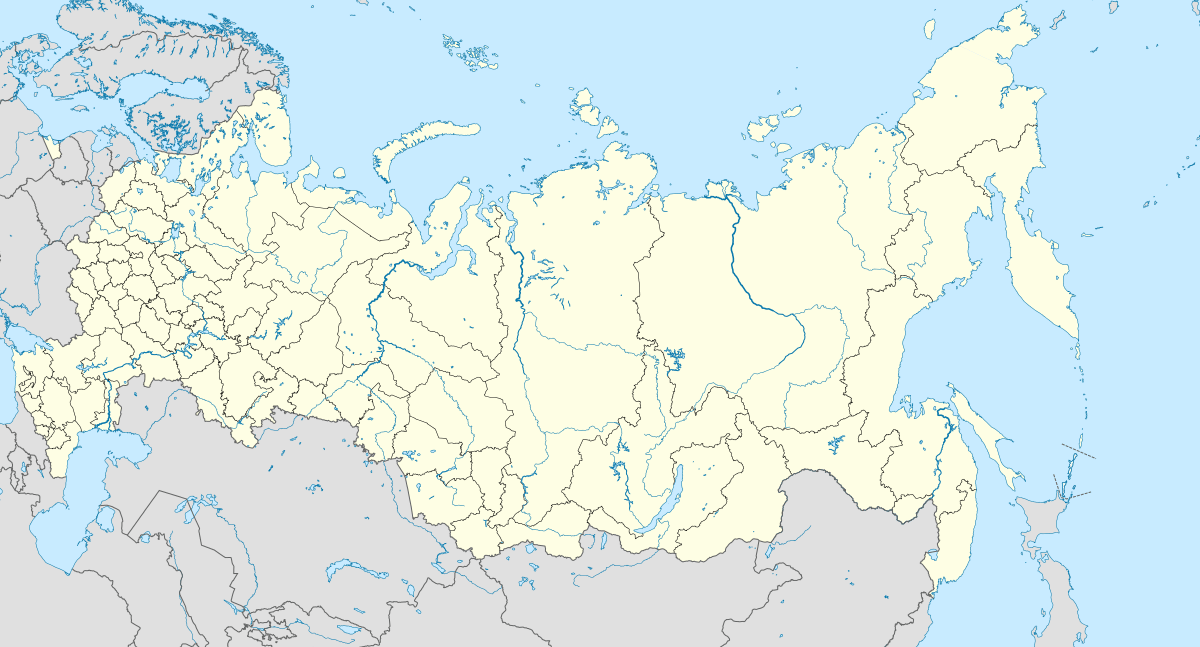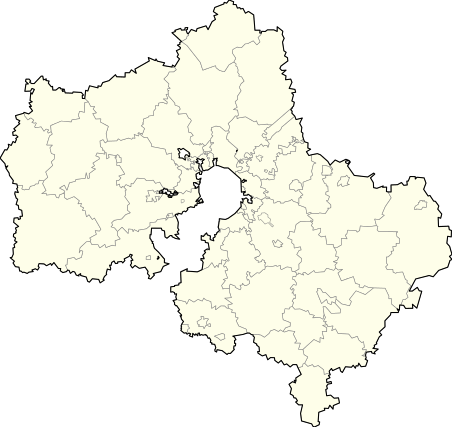A-135 anti-ballistic missile system
| 51T6 (ABM-4 Gorgon) | |
|---|---|
| Type | Anti-ballistic missile |
| Place of origin | Soviet Union |
| Service history | |
| In service | Since 1995 |
| Used by | Russia |
| Wars | Cold War |
| Production history | |
| Designer | NPO Novator Design Bureau |
| Designed | 1978 |
| Produced | 1988 |
| Number built | 68 |
| Specifications | |
| Weight | 33,000-45,000kg (73,000-100,000lb) |
| Length | 19.8 m[1] |
| Diameter | 2.57m[2][3] |
| Warhead | nuclear 10 kt |
|
| |
| Engine | 2-stage solid fuel |
Operational range | 350-900km[4] |
| Flight ceiling | 350-900km |
| Speed | Mach Mach 25 (30,626 km/h; 19,030 mph; 8.5073 km/s) |
Launch platform | silo, launcher(?)[5][6] |
The A-135 (NATO: ABM-3) anti-ballistic missile system is a Russian military complex deployed around Moscow to counter enemy missiles targeting the city or its surrounding areas. It became operational during 1995. It is a successor to the previous A-35, and compliant with the 1972 Anti-Ballistic Missile Treaty from which the US unilaterally withdrew in 2002.
The A-135 system attained "alert" (operational) status on February 17, 1995. It is operational although its 51T6 (NATO reporting name: SH-11) component was deactivated in February 2007. A newer missile is expected to replace it. There is an operational test version of the system at the test site in Sary Shagan, Kazakhstan.
The system is operated by the 9th Division of Anti-Missile Defence, part of the Air Defence and Missile Defence Command of the Russian Aerospace Defence Forces.[8][9]
A-135


A-135 consists of the Don-2N battle management radar and two types of ABM missiles. It gets its data from the wider Russian early warning system which is sent to the command centre which then forwards tracking data to the Don-2N radar.[7]
- The Don-2N radar (NATO: 'Pill Box') is a large battle-management phased-array radar with 360° coverage.[10][11] Tests were undertaken at the prototype Don-2NP in Sary Shagan in 2007 to upgrade its software.[11][12]
- 68 launchers of short-range 53T6 (NATO: SH-08 'Gazelle') endoatmospheric interceptor nuclear-tipped missiles at five launch sites with 12 or 16 missiles each. Designed by NPO Novator, similar to US Sprint missile. These are tested roughly annually at the Sary Shagan test site.[13]
| Location[14] | Coordinates [7] | Number [7][14] | Details |
|---|---|---|---|
| Sofrino | 56°10′51.97″N 37°47′16.81″E / 56.1811028°N 37.7880028°E | 12 | Co-located with the Don-2N radar |
| Lytkarino | 55°34′39.04″N 37°46′17.67″E / 55.5775111°N 37.7715750°E | 16 | |
| Korolev | 55°52′41.09″N 37°53′36.50″E / 55.8780806°N 37.8934722°E | 12 | |
| Skhodnya | 55°54′04.11″N 37°18′28.30″E / 55.9011417°N 37.3078611°E | 16 | |
| Vnukovo | 55°37′32.45″N 37°23′22.41″E / 55.6256806°N 37.3895583°E | 12 |
- Currently decommissioned 16 launchers of long-range 51T6 (NATO: SH-11 'Gorgon') exoatmospheric interceptor nuclear-tipped missiles at two launch sites with eight missiles each.[7]
| Location[14] | Coordinates [7] | Number [7][14] | Details |
|---|---|---|---|
| Sergiyev Posad-15 | 56°14′33.01″N 38°34′27.29″E / 56.2425028°N 38.5742472°E | 8 | Site was also used in the A-35 system |
| Naro-Fominsk-10 | 55°21′01.16″N 36°28′59.60″E / 55.3503222°N 36.4832222°E | 8 | Site was also used in the A-35 system |
A memo from the archives of Vitalii Leonidovich Kataev, written circa 1985, had envisaged that the system "will be completed in 1987 to provide protection from a strike of 1-2 modern and prospective ICBMs and up to 35 Pershing II-type intermediate-range missiles."[15]
Russian Early Warning System
The wider early warning system consists of:[14]
- Two Daryal-type (NATO: 'Pechora') bistatic phased-array early warning radars, deployed at Pechora and Qabala radar (closed in 2012) in Qabala, Azerbaijan.
- Dnepr (NATO: Hen House) radars at Mishelevka (Irkutsk), Olenegorsk, and Balkhash, Sary Shagan, Kazakhstan.
- Voronezh radar
- US-KMO and US-K satellites.
- Command, control, communications and intelligence services.
Successor
The successor system, dubbed 'Samolet-M' (and more recently A-235) supposedly will employ a new, conventional, variant of the 53T6 missile to be deployed in the former 51T6 silos.[16][17][18]
See also
References
- ↑ http://www.astronautix.com/lvs/51t6.htm
- ↑ http://militaryrussia.ru/blog/topic-345.html
- ↑ http://www.astronautix.com/lvs/51t6.htm
- ↑ http://militaryrussia.ru/blog/topic-345.html
- ↑ http://ausairpower.net/APA-Rus-ABM-Systems.html#mozTocId700952
- ↑ http://militaryrussia.ru/blog/topic-345.html
- 1 2 3 4 5 6 7 O'Connor, Sean (2012). "Russian/Soviet Anti-Ballistic Missile Systems". Air Power Australia. Retrieved 2012-04-30.
- ↑ "Air space defence troops". BE: Warfare. Retrieved 17 June 2012.
- ↑ Stukalin, Alexander (May 2012). "Russian Air and Space Defense Troops: Gaping Holes". Moscow Defense Brief. Centre for Analysis of Strategies and Technologies (2).
- ↑ "Don-2NP Pill Box". Global Security.
- 1 2 "Russia is modernizing the Don-2N radar". Russian Strategic Nuclear Forces. 2007-12-29.
- ↑ Bukharin, Oleg; Kadyshev, Timur; Miasnikov, Eugene; Podvig, Pavel; Sutyagin, Igor; Tarashenko, Maxim; Zhelezov, Boris (2001). Podvig, Pavel, ed. Russian Strategic Nuclear Forces. Cambridge, MA: MIT Press. ISBN 0-262-16202-4.
- ↑ "Test of a missile defense interceptor". Russian Strategic Nuclear Forces. 2011-12-20.
- 1 2 3 4 5 Podvig, Pavel (2012-01-30). "Early Warning". Russian Strategic Nuclear Forces. Retrieved 24 March 2012.
- ↑ http://russianforces.org/blog/2012/10/very_modest_expectations_sovie.shtml
- ↑ Honkova, Jana (April 2013). "Current Developments in Russia's Ballistic Missile Defense" (PDF). George C. Marshall Institute. Retrieved 9 June 2013.
- ↑ "A-235 Samolet-M". George C. Marshall Institute. n.d. Retrieved 9 June 2013.
- ↑ Russia Revamps Missile Defenses Around Moscow MOSCOW, September 17, 2012 (RIA Novosti)
External links
- "Test launch", Function (video) (in Russian), RU, 2011.
- "DON-2N photos", Military legacy of the USSR, English Russia, 2012-12-29.
